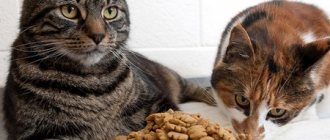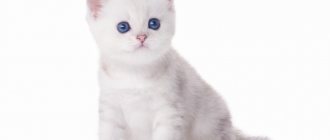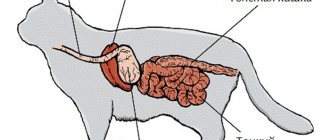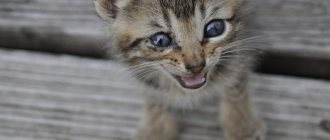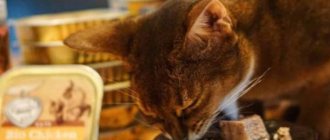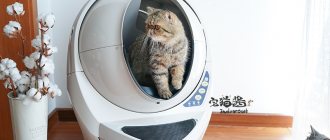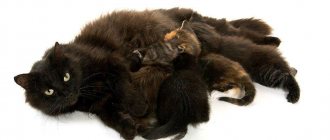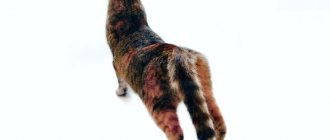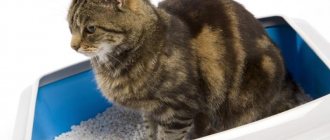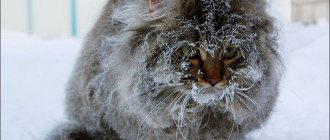Megacolon often occurs in cats as a result of pelvic injuries, deterioration of the nervous system, or stress. Doctors recommend contacting a veterinary clinic for advice immediately after detecting changes in the animal’s behavior. This will help avoid serious consequences such as lethargy or intestinal rupture. Pathology can be treated in two ways: surgery and drug therapy.
Megacolon: what is it and its difference from constipation
Constipation is the most understandable and common name for a digestive problem in cats, also called constipation. It stands for a systematic violation of bowel movements, but the fact of defecation itself is present, albeit in a difficult form.
Megacolon is a long-term constipation in which the colon becomes overfilled with dry and very hard feces. It (usually) cannot be treated with medication and requires surgical intervention.
Symptoms
Clinical manifestations depend on the neglect of the process and its course. Owners of furry cats may notice that after the cat visits the toilet, the tray remains empty. In rare cases, small dry feces similar to goat feces can be seen after defecation. Cats can sit on the tray for a long time before defecating.
Signs of megacolon:
- difficult, painful, rare process of defecation;
- weight loss, weakness;
- increased thirst;
- vomiting, nausea due to intoxication;
- yellowness of mucous membranes;
- deterioration of coat condition;
- decreased activity, drowsiness, apathy.
When cats become ill, their appetite decreases or disappears completely. Animals become inactive and do not want to take part in outdoor games. When palpating the peritoneum, the animal may experience severe pain. The abdomen is enlarged and tight. Occasionally, liquid seeps between hardened stools, resulting in watery, foamy diarrhea with blood.
Severe, prolonged distension of the colon causes irreversible effects on the smooth muscles and nerves of the intestine, which can lead to complete atony. If you notice that your beloved pet often suffers from constipation, defecation occurs rarely and is accompanied by discomfort and pain, urgently take your pet to the veterinary clinic.
Causes of the pathological condition
The breed or age of megacolon cats has not been identified, but, according to the observations of doctors at the RosVet EC, cats (65-70%) aged 5 to 8 years and smooth-haired cats (42-48%) are most often seen at the reception.
Animals with excess body weight (obesity) are at risk.
List of possible reasons:
- idiopathic megacolon develops as a primary disease if pathologies of the muscular wall of the intestine are present or contractility of the colon is impaired;
- pain of various origins that interferes with normal bowel movements (foreign body, intestinal abscesses, anal injury, joint problem that prevents one from taking a specific position);
- inconvenient tray (wrong place chosen, people and animals get in the way). Cats want to do their natural needs without witnesses and with comfort; failure to comply with these conditions provokes marks in the wrong places, constipation and megacolon;
- metabolic disorders (metabolism), a decrease in potassium and calcium in the blood leads to changes in intestinal motility, thyroid disease leads to dysfunction of the gastrointestinal tract;
- pathologies of the central nervous system (neurology), in particular lumbar injuries, tail fractures, spinal deformity;
- intestinal obstruction (tumors, strictures, foreign bodies, etc.);
- Dehydration causes the formation of dry and hard stool.
Any of these reasons can trigger megacolon. In addition, during treatment it is necessary to eliminate all provoking factors, otherwise the re-development of the pathology is inevitable.
Prevention
Most often, problems with the gastrointestinal tract lead to rectal prolapse. To avoid them, it is necessary to provide the cat with a complete and balanced diet, especially for kittens under one year old. Cats can be fed natural food or commercial food.
You might be interested in: Why does a cat shake its head?
The pet needs to be given premium and super-premium food. Economy class industrial feeds are poorly balanced and contain various harmful additives. They often lead to digestive disorders and the development of urolithiasis.
Cats that eat only dry food should always have clean drinking water freely available.
A natural diet should consist of the following products:
- Meat (chicken, turkey, lean veal) and offal.
- Cereals.
- Low-fat fermented milk products.
- Vegetables.
- Cats should not be given fish more than once a week. It must be a sea fish from which the bones have been removed.
The following should be completely excluded from the diet:
- sweets (especially dark chocolate, which is poisonous to cats);
- potatoes and legumes;
- fatty pork and smoked meats;
- chicken tubular bones;
- salt and spices;
- milk after the kitten is 4 months old.
It is also necessary to periodically prevent helminth infection. Anthelmintic drugs should be given even to animals that do not go outside, but constantly live at home. Infection can occur through the owner's street clothes.
The drug prescribed by the veterinarian is given to the cat in the morning on an empty stomach. You can feed the animal a couple of hours after this. Preventive deworming should be carried out every 3-4 months. This is especially true for street animals. If, after deworming, worms come out in the feces, the cat should be given the tablet again after 10-12 days.
There should be no freely accessible items that animals can swallow. Cellophane bags, threads, and New Year's rain are especially dangerous.
The vaccination schedule should be monitored. The first vaccinations are given to a kitten at two months of age. An adult animal is vaccinated once a year, regardless of whether the cat has free access to the street or is constantly at home.
You should also pay close attention to the general health of the animal.
Symptoms that indicate that your pet needs to be seen urgently by a doctor:
- frequent constipation or diarrhea;
- frequent vomiting;
- decreased activity;
- increased salivation;
- change in wool quality;
- increased body temperature;
- bad breath;
- restless behavior of an animal for no reason.
Don't ignore your pet's health problems. Most diseases can be completely cured only in the first stages.
Clinical signs
The cat owner notices behavioral changes; if normally, bowel movements go almost unnoticed, then with megacolon the animal constantly runs to the litter box, sits there for a long time, strains, and meows.
Gradually, her general condition worsens, the cat refuses food and becomes lethargic. If defecation is successful, the feces are very hard, dry, and small in volume. When the intestinal walls are damaged, there is blood and mucus.
The inability to empty the intestines provokes vomiting, so the overfilled stomach is freed from excess.
Mr. Cat Recommends: Effective Home Remedies
In case of constipation, there is no need to immediately stuff your animal with medications. Sometimes they are necessary, but most often you can get by with effective and safe folk remedies.
Here are some good recipes:
- Condensed milk. Condensed milk is mixed with clean water in a ratio of 1:3, and given to the cat in small quantities (no more than a tablespoon) several times a day. The time interval between laxative doses should be at least three hours, and in total the laxative should be given no more than five times a day. Diabetes mellitus is a contraindication to the use of this method.
- Vegetable oils (coke, linseed, olive). A few drops of oil should be added to the animal's food. You can’t overdo it; you should give no more than a quarter of a teaspoon. This method can only be used in extreme cases, when no other laxatives are available. Vegetable oils have a negative effect on the cat’s liver and can cause discomfort and negative reactions from the intestines. Veterinarians do not recommend using oils as a laxative. Only adult animals can be treated in this way.
- Vaseline oil, castor oil. These agents help move stool through the intestines. Vaseline or castor oil should be given to your cat using a special syringe. It is best to discuss dosages with your veterinarian. The optimal dose is calculated based on the weight of the animal (about 1.5 ml per kilogram of weight). After taking such a laxative, it is necessary to limit the cat's food intake. It is advisable not to give anything before bowel movement. Usually, defecation occurs after 3-5 hours. If there is no effect during this time, you need to repeat taking the product.
- Milk. For cats, the whole product has a laxative effect. Warm milk is given in small quantities, several times a day. You cannot overdo it with this remedy, as an overdose can cause severe diarrhea.
- Freshly squeezed vegetable juices and raw vegetables. As a laxative, you can give your pet a few pieces of beets, pumpkin or carrots, as well as juice from these vegetables.
If there are plants in the house, or the cat walks outside, then, following instinct, it can pick up a laxative for itself. Plants with a laxative effect:
You can prepare a decoction from these plants and give your cat water several times a day. It is better to make it one-component, taking a tablespoon of any herb per glass of boiling water. After standing, cooling and straining the product, it should be given to the animal 1-2 teaspoons every 3-4 hours.
In addition to oral remedies, there are other methods to combat constipation. The most effective and fastest way to alleviate a cat’s condition is a cleansing enema.
It is advisable that the procedure be performed by a veterinarian or nurse.
If the owner has some experience, he can give his pet an enema himself. To carry out the procedure, take warm water or chamomile decoction. It is necessary to monitor the temperature of the liquid so as not to cause pain or discomfort to the cat.
Another way to stimulate intestinal peristalsis so that it is freed from feces is abdominal massage. Only the owner can do it, since cats really do not like touching the most vulnerable part of the body from their point of view. You should calm the cat down, and then slowly stroke it, without pressing too hard, in a clockwise circular motion. The massage procedure is carried out after taking a laxative.
Diagnostic rules for megacolon
The disease is polyetiological, which means that the examination of the cat at the RosVet EC will be carried out taking into account all possible causes provoking megacolon. It is mandatory to collect:
- medical history (conditions of keeping, feeding, watering, etc.);
- data on the possibility of a cat swallowing foreign objects.
A neurological examination often includes a computed tomography scan with cerebrospinal fluid sampling. A colonoscopy is performed, the colon is examined endoscopically and samples are taken for cytological examination.
Ultrasound of the abdominal cavity and radiography make it possible to differentiate megacolon from constipation and coprostasis; this is important, since the treatment for all three pathological conditions is different. Using pictures (X-rays), you can visualize foreign bodies in the intestinal lumen and neoplasms.
To assess the general health of the cat, standard laboratory tests are performed: general and biochemical blood and urine tests. It is also recommended to check the functioning of the endocrine glands, in particular the thyroid hormone T4.
Features of treatment of megacolon in cats
At the RosVet VC, two methods are used to treat megacolon: conservative (medicinal) and surgical. The choice of priority directly depends on the cause of the pathology and the general condition of the cat admitted for treatment.
Therapeutic (medicinal) method:
- if there is no critical dehydration of the body, then normal hydration is maintained by administering infusion solutions subcutaneously or intravenously;
- wet, bulky food and water are added to the diet to soften dry excrement in the intestines;
- provide access to the litter box that the cat likes (a secluded place, remove irritants, animals, etc.);
- cleanse the intestines of dense feces (enema, mechanical cleansing under anesthesia) to reduce injury to the walls and eliminate intoxication;
- intestinal prokinetics, drugs that improve peristalsis or laxatives are prescribed.
The use of lubricants that accelerate the passage of stones through the intestine is justified - this is Vaseline oil, administered rectally. The mistake is to give it by mouth, as this often provokes aspiration pneumonia if the oil gets into the lungs.
Lactulose, magnesium salts (not given in case of renal failure), polyethylene glycols (not given in case of intestinal obstruction) are hyperosmotic laxatives that “attract” excess moisture into the intestines and facilitate the excretion of feces
Surgery
Subtotal colectomy is a radical surgical solution used if other therapeutic methods are powerless for megacolon. The essence of the operation is to remove part of the colon in which fecal matter has frozen and has ceased to function normally.
The outcome of surgical intervention, as well as the prognosis, directly depends on the condition of the animal and the gastrointestinal tract at the time of the intervention. Age, the degree of damage to the intestinal walls, the length of the megacolon, and whether there is distension and perforation of the intestine are taken into account.
A common postoperative complication is loose stools, which may not go away for several months. But the veterinarians of the RosVet VC do everything to eliminate or minimize such gastrointestinal disorders, and also achieve the animal’s recovery in a short time.
It is important to know! A cat that has undergone treatment for megacolon will need to be on a diet for life. The owner needs to maintain normal living conditions and eliminate all factors that could trigger the re-development of the pathology.
If you notice that your cat is acting restless, cannot go to the toilet for a long time, but at the same time demonstrates its readiness to defecate - do not hesitate! Call the RosVet Center 24 hours a day and bring your pet for examination. The clinic's doctors are available 24 hours a day.
When does a cat need a laxative?
Constipation can be caused by various reasons. It is necessary to analyze what the animal ate over the past days; perhaps something poorly digestible was eaten. Constipation can also occur when hairballs are swallowed. Other reasons for lack of bowel movements include:
Constipation isn't just limited to humans.
- errors in the animal’s feeding diet and unbalanced food or lack of food;
- colon hypertrophy (megacolon);
- inflammatory diseases of the stomach, all parts of the intestines, renal failure;
- worm infestations;
- neoplasms;
- low mobility of the animal due to age or injury;
- change of place where the animal is kept.
For your information! As cats age, they develop a predisposition to constipation due to decreased muscle tone and mobility.
Laxatives for cats are used to alleviate the condition of animals in the absence of problems requiring surgical treatment. Constipation caused by stress is primarily eliminated by improving living conditions and ensuring normal bowel movements, for example, changing the litter tray and cat litter.
If feeding and diet regimens are violated, these unfavorable factors are eliminated. A cat may need a laxative after castration, since this is also a stressful situation, and the body may react to it, manifested by decreased appetite and constipation.
Tense pose of a cat with constipation problem
Note! Before spaying or neutering cats, only a veterinarian will prescribe a laxative.
